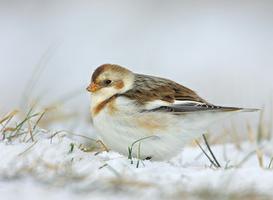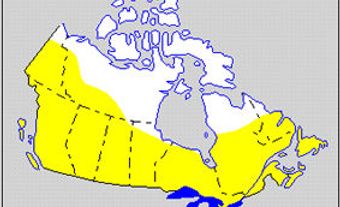
Bunting is a common name for several not particularly closely related members of the order Passeriformes (perching birds). Four species are included in this group: indigo, lazuli, lark and snow buntings, all of which nest in Canada. Indigo and lazuli buntings are members of the cardinal family (Cardinalidae); lark bunting is a member of the sparrow family (Emberizidae); and the snow bunting is a member of the longspur family (Calcariidae). None of these four bunting species is considered endangered in Canada.
Range and Habitat
The indigo bunting (Passerina cyanea) nests in open deciduous forests and parkland from southern Manitoba, across southern Ontario and southwestern Québec to southern New Brunswick; its western counterpart, lazuli bunting (P. amoena), in brush country from southern British Columbia to southern Saskatchewan; lark bunting (Calamospiza melanocorys) breeds locally in the open grassy prairies of southern Alberta, Saskatchewan and southwestern Manitoba; and snow bunting (Plectrophenax nivalis), a circumpolar species, on tundra, wintering in open country in southern Canada and the northern United States.
Description
Male indigo buntings are blue all over; male lazuli buntings have blue heads and backs, 2 white wing bars and cinnamon breasts shading to white on the abdomen. Female indigo and lazuli buntings have quite similar dull brown plumage. The female lazuli bunting has 2 wing bars. Both species are around 14 cm long. Hybrids have been discovered where ranges overlap. Both species are migratory, wintering in Mexico and Central America.
Male lark buntings are all black with large, white wing patches; females are brown with dark streaks and light wing patches. Their numbers and breeding-range boundaries fluctuate considerably from year to year. Males often sing in flight, holding their wings at an angle above the body and circling slowly back to earth while uttering a long and varied song of whistles, trills and buzzes.
Snow bunting males retain their black wings and back but are otherwise almost immaculate in breeding plumage. Females, and males outside the breeding season, are slightly duller. In Canada snow buntings are among the most northerly of nesting birds, breeding up to northern Ellesmere Island. Flocks of snow buntings are a familiar sight in most of southern Canada in winter, usually over weedy fields and stubble.

 Share on Facebook
Share on Facebook Share on X
Share on X Share by Email
Share by Email Share on Google Classroom
Share on Google Classroom



